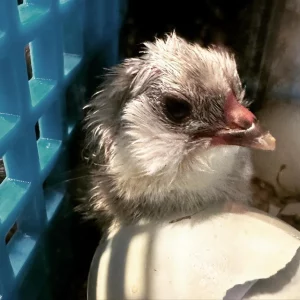A lot of people ask us how to help chicks hatch. We are assisting a struggling chick right now, so I thought I’d write a post about our experience and steps we take.
Please note that we are not medical experts and the following should in no way be considered medical advice. We always recommend consulting a veterinarian.
Right now, we are helping a little Black Ameraucana who hit a blood vessel when it pipped. It is too weak to zip and escape its shell on its own. It might otherwise be healthy, or it might have some sort of internal or external deformity. We won’t know unless it manages to hatch.
Prognosis
The prognosis for a chick who can’t hatch on its own is not great. We’ve had about a 50/50 success rate with assisted hatches. The chicks often have some sort of disability, and unfortunately, many don’t survive very long. Two of our favorite survivors have been Bobby, who hatched blind, and Frankie, who hatched with a fused club foot. Both had an incredibly strong will to live. Both get around just as well as their siblings! We are softies for the special cases like theirs.
Even if they are stuck due to environmental factors, such as shrink wrapping, a chick’s vitality is negatively affected if it needs assistance. It’s the same way c-section babies sometimes have more lung issues than naturally-birthed ones. As a c-section baby, I have firsthand experience! When a chick struggles to hatch and breathe, that movement causes it to absorb the vital blood and yolk that it needs to survive. If someone just cracks the shell and pulls the chick out, it will die almost every time. If it survives, it is almost always weak and stunted compared to its siblings.
Assistance Steps
Here’s how we assist chicks: First, we wait until all the strong chicks finish hatching and dry off. Then we pull those ones out so that they don’t bother their struggling sibling(s).
Every few hours, we chip away a tiny bit more of the stuck chick’s shell & membrane along what should be the zip line. If we see blood, we stop immediately and wait a couple more hours. As we go, we add a little bit of coconut oil, being careful to avoid the chick’s face and beak. This keeps the membrane from drying out and trapping the chick. Once we get almost all the way around the shell, we leave the top piece covering the chick so that they’re forced to push it off themselves. This hugely affects the chick’s odds of success – somehow, that act of pushing is very important. If the chick does not get out of the shell at that point, it’s unfortunately almost always doomed.
We are about halfway through unzipping our little Black Ameraucana chick and are rooting for him/her!
*** Update #1, 6 hours after posting – we zipped the shell about 3/4 of the way for the chick and he successfully hatched. He is weak and unable to sit up straight, but excited to drink water and chirping happily. We’ll see how things go!
*** Update #2, July 19 – So far, this spunky baby is still doing well! They’re smaller than the other chicks, but is running around with a zest for life. We will tentatively call this one a success!





